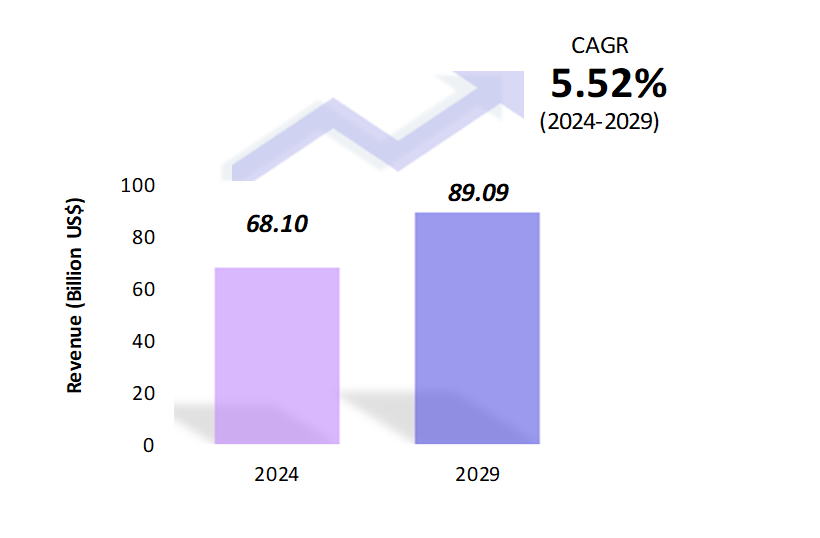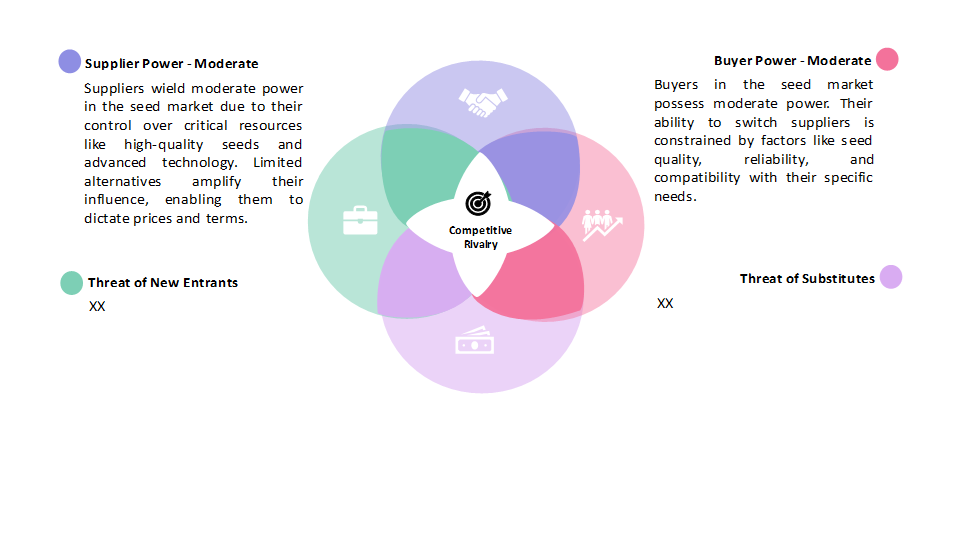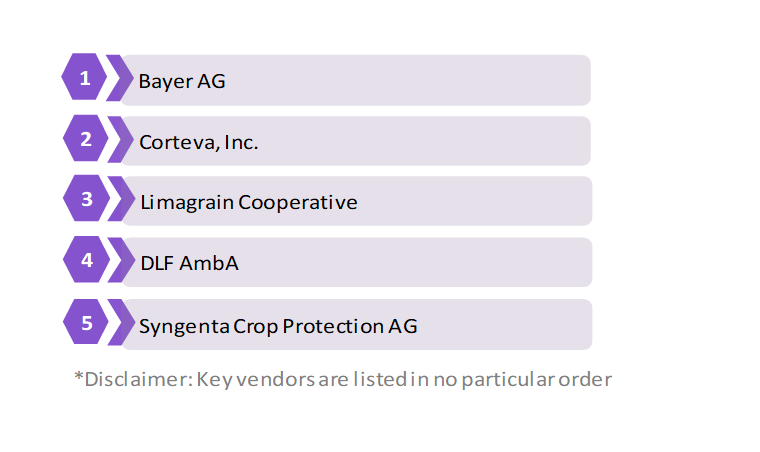Seed Market Outlook: Size, Share, Trends & Growth Analysis (2024-2029)
The report covers a comprehensive analysis segmented by Type (Genetically Modified, Conventional), by Trait (Herbicide Tolerance, Insect Resistance, Others), by Crop Type (Cereals & Grains, Oilseeds, and Pulses, Fruits & Vegetables, Others), by Geography (North America, South America, Asia Pacific, Europe, The Middle East, Africa).
Seed Market Snapshot

Seed Market Overview
The global seed market is estimated to be at $68.1 Bn in 2024 and is anticipated to reach $89.09 Bn in 2029. The global seed market is registering a CAGR of 5.52% during the forecast period 2024-2029.
The global seeds market encompasses a wide array of crop varieties, including cereals, grains, vegetables, fruits, and oilseeds, serving as the foundation of agricultural production worldwide. The need for seeds is increasing due to the world’s population, which is expected to reach over 9 billion by 2050. These factors are being pushed by the need to increase crop yields, improve food security, and adapt to changing environmental circumstances.
High-yielding crop varieties with desirable qualities like insect resistance, drought tolerance, and higher nutritional content have been developed as a result of genetic alteration, hybridization, and advanced breeding techniques that have transformed the seed industry. Biotechnology innovations have enabled the commercialization of genetically modified (GM) seeds, sparking debates surrounding safety, environmental impact, and intellectual property rights.
Innovation and research in digital agriculture are reshaping the seed market, with technologies like data analytics, drones, and artificial intelligence optimizing planting, monitoring, and harvesting processes. Precision agriculture techniques enable farmers to make data-driven decisions, improving efficiency, productivity, and resource utilization.
However, there are obstacles facing the seed industry, such as complicated regulations, biopiracy, genetic erosion, and the effects of climate change. Stringent regulations governing seed production, distribution, and trade vary across regions, creating barriers to market entry and increasing compliance costs for companies operating internationally. Biopiracy threatens indigenous rights and biodiversity conservation efforts, while climate change exacerbates challenges related to agricultural productivity and environmental sustainability.
Despite these challenges, the global seeds market presents opportunities for innovation, collaboration, and sustainable agriculture practices. Investments in research and development, public-private partnerships, and initiatives to promote seed sovereignty and biodiversity conservation are essential for ensuring a resilient and equitable seed market that meets the needs of present and future generations.
Seed Market Coverage
| Historical & Forecast Period | 2018-2029 |
| Base Year | 2023 |
| Forecast Period | 2024-2029 |
| Units | Billion US$ |
| Segments | Type, Trait, Crop Type |
| Geographies | North America, South America, Asia Pacific, Europe, The Middle East, Africa |
| Key Vendors | Bayer AG, Corteva, Inc., Limagrain Cooperative, DLF AmbA, Syngenta Crop Protection AG |
Key Geographies of Seed Market, 2023

Porter’s 5 Forces Analysis of Seed Market

Seed Market Trends
The global seeds market is witnessing a significant trend towards sustainability and innovation driven by factors such as population growth, climate change, and evolving consumer preferences. One prominent trend is the increasing adoption of genetically modified (GM) seeds designed to enhance crop resilience, yield, and nutritional content. However, this trend is accompanied by debates surrounding safety, environmental impact, and intellectual property rights.
Another noteworthy trend is the rising demand for organic and non-GMO seeds, fueled by growing consumer awareness of health and environmental concerns. This shift towards more natural and sustainable farming practices is driving investments in research and development of organic seed varieties. For Example, High Mowing Organic Seeds; High Mowing is a Vermont-based seed company that specializes in organic, non-GMO seeds for vegetables, herbs, and flowers.
Moreover, there is a growing emphasis on digitalization and precision agriculture in the seeds market. Technologies like data analytics, drones, and artificial intelligence are being leveraged to optimize planting, monitoring, and harvesting processes, leading to improved efficiency and resource utilization. For Instance, in 2013, Monsanto global seeds and agricultural biotechnology company acquired The Climate Corporation, a digital agriculture company specializing in data analytics and predictive modeling for farming operations. The collaboration aimed to integrate The Climate Corporation’s expertise in data science with Monsanto’s seed genetics and agronomic knowledge to provide farmers with advanced digital tools for decision-making.
Furthermore, the evolution of regulatory frameworks governing seed production and distribution is influencing market dynamics and business strategies. Increased stringency in regulations concerning genetically modified (GM) seeds, intellectual property rights, and trade agreements are shaping market entry barriers and competition.
Overall, the global seeds market is undergoing transformative changes driven by sustainability, technology, market consolidation, and regulatory developments.
Seed Market Driving Factors
With the world’s population steadily increasing, there is a growing demand for food production. This drives the need for high-yielding and resilient seeds to ensure food security, especially in regions facing challenges such as climate change and limited arable land. For Example, in the 1970s, Chinese scientist Yuan Longping pioneered the development of hybrid rice, which significantly increased yields compared to traditional rice varieties. Hybrid rice combines the advantages of different rice strains, resulting in plants with higher yields, better resistance to pests and diseases, and improved tolerance to environmental stressors such as drought. The widespread adoption of hybrid rice in China has played a crucial role in boosting rice production and ensuring food security for the country’s population. Also, companies like Monsanto (Bayer Crop Science) and Syngenta have developed genetically modified maize (corn) varieties that can withstand prolonged periods of drought while maintaining respectable yields. These seeds are designed to be more resilient to water stress, allowing farmers to produce crops even during dry spells.
Innovations in biotechnology, genetics, and digitalization have transformed the seeds market. Genetic modification techniques enhance crop traits such as pest resistance and yield potential, while digital technologies like data analytics and drones optimize farming practices, improving efficiency and productivity. For Example, Monsanto developed genetically modified seeds with traits such as insect resistance, herbicide tolerance, and increased yield potential. One of their products is Roundup Ready soybeans, which are genetically engineered to tolerate glyphosate herbicides, allowing farmers to control weeds more effectively.
The increasing frequency of extreme weather events and shifts in climatic patterns pose challenges to agricultural productivity. This drives the demand for seeds with traits such as drought tolerance, heat resistance, and adaptability to changing environmental conditions. For Instance, The Drought Tolerant Maize for Africa (DTMA) project, was launched by the International Maize and Wheat Improvement Center (CIMMYT) in collaboration with national agricultural research institutions and seed companies across several African countries. Through this project, drought-tolerant maize hybrids and varieties have been developed using conventional breeding techniques to withstand prolonged periods of water scarcity.
Mergers and acquisitions within the seeds industry led to market consolidation, with large multinational corporations dominating the market. This consolidation affects competition, innovation, and access to diverse seed varieties.
Rapid urbanization results in the shrinking of agricultural land leading to land constraints for farming. This drives the need for seeds that can maximize yield in limited spaces, such as urban agriculture and vertical farming.
Seed Market Challenges
Stringent regulations governing seed production, distribution, and trade vary across regions and countries, posing compliance challenges for companies operating in multiple jurisdictions. Regulatory hurdles related to genetically modified organisms (GMOs), intellectual property rights (IPRs), and trade agreements create barriers to market entry and increase administrative burdens. For Example, The European Union (EU) has established a comprehensive regulatory framework for the approval, cultivation, and importation of GM crops, governed primarily by Regulation (EC) No 1829/2003 and Regulation (EC) No 1830/2003.
The exploitation of indigenous plant varieties without proper compensation, known as biopiracy, threatens seed sovereignty and traditional knowledge systems. The commercialization of seeds derived from indigenous crops without the consent of local communities undermines biodiversity conservation efforts and indigenous rights. For Example, in 2020 a US-based company, Phyton Biotech, was accused of biopiracy by the Government of Madagascar. The dispute centered around Phyton Biotech’s attempts to patent a plant extract derived from the Madagascar periwinkle (Catharanthus roseus), a plant native to Madagascar.
The widespread adoption of high-yielding crop varieties, often promoted by large seed companies, has led to the displacement of traditional landraces and heirloom varieties. This genetic erosion reduces agricultural resilience to pests, diseases, and environmental stresses, jeopardizing long-term food security.
Changing climatic patterns, including extreme weather events, droughts, and floods, pose significant challenges to seed production and crop yields. Variability in weather conditions affects seed quality, germination rates, and overall agricultural productivity, exacerbating food insecurity in vulnerable regions.
Consolidation within the seeds industry, characterized by mergers and acquisitions among large multinational corporations, raises concerns about market monopolization and reduced competition. This concentration of market power may limit seed diversity, innovation, and farmer choice, ultimately influencing seed prices and availability.
Seed Market – Key Industry News
- In October 2023, Union Home and Cooperation Minister Amit Shah has launched a national-level multi-state seed cooperative society, aimed to increase India’s share in the global seed export market.
- In September 2023, Crystal Crop Protection Limited, a crop protection manufacturer in India, has announced the acquisition of the Sadanand Cotton Seeds business from Kohinoor Seeds.
- In July 2023, Syngenta Vegetable Seeds announced that it has completed the acquisition of Feltrin Sementes, a leading Brazilian vegetable seed company serving smallholder growers and home gardeners in 40+ countries.
Seed Market Competitive Landscape
The competitive landscape of the seed market is diverse and dynamic, with numerous players operating globally, regionally, and locally. Here’s an overview of the key aspects:
Companies like Bayer AG, Syngenta, Corteva Agriscience, and others dominate the global seed market. These companies often have extensive research and development capabilities, enabling them to produce genetically modified seeds (GMOs) and advanced hybrids with desirable traits such as disease resistance, higher yields, and drought tolerance. For Instance, Monsanto invested heavily in biotechnology research to develop Roundup Ready Soybeans. This involved years of research into plant genetics, gene editing techniques, and agronomic studies to identify and incorporate the desired trait of glyphosate resistance into soybean plants.
Startups and smaller companies are increasingly entering the seed market, leveraging advancements in biotechnology, data analytics, and machine learning. These players often target niche markets or specific crop types with innovative solutions. For Example, Indigo Agriculture, founded in 2014, is a company that focuses on harnessing the power of plant microbiomes to improve crop health and productivity.
Industry associations and collaborative initiatives bring together various stakeholders, including seed companies, researchers, policymakers, and farmers, to address common challenges, share knowledge, and promote best practices.
The seed market is heavily regulated, particularly concerning GMOs and intellectual property rights (IPR) related to seed varieties. Regulatory frameworks vary between countries and regions, impacting market access and product development strategies for seed companies. Digital agriculture technologies, such as precision farming and data-driven decision-making tools, are also shaping the seed market by enhancing efficiency and productivity.
Overall, the seed market is characterized by intense competition, rapid technological advancements, and evolving consumer and regulatory landscapes, driving innovation and diversification among market players.
Seed Market Company Share Analysis, 2023 (%)

Seed Market – Key Companies

Reason to Buy from us

Table of Contents
| 1. Introduction |
|---|
| 1.1. Research Methodology |
| 1.2. Scope of the Study |
| 2. Market Overview / Executive Summary |
| 2.1. Global Seed Market (2018 – 2022) |
| 2.2. Global Seed Market (2023 – 2029) |
| 3. Market Segmentation |
| 3.1. Global Seed Market by Type |
| 3.1.1. Genetically Modified |
| 3.1.2. Conventional |
| 3.2. Global Seed Market by Trait |
| 3.2.1. Herbicide Tolerance |
| 3.2.2. Insect Resistance |
| 3.2.3. Others |
| 3.3. Global Seed Market by Crop Type |
| 3.3.1. Cereals & grains |
| 3.3.2. Oilseeds and pulses |
| 3.3.3. Fruits & Vegetables |
| 3.3.4. Others |
| 4. Regional Segmentation |
| 4.1. North America |
| 4.1.1. The U.S |
| 4.1.2. Canada |
| 4.1.3. Mexico |
| 4.2. South America |
| 4.2.1. Brazil |
| 4.2.2. Argentina |
| 4.2.3. Colombia |
| 4.2.4. Chile |
| 4.2.5. Rest of South America |
| 4.3. Asia Pacific |
| 4.3.1. China |
| 4.3.2. India |
| 4.3.3. Japan |
| 4.3.4. South Korea |
| 4.3.5. Rest of Asia Pacific |
| 4.4. Europe |
| 4.4.1. UK |
| 4.4.2. Germany |
| 4.4.3. Italy |
| 4.4.4. France |
| 4.4.5. Spain |
| 4.4.6. Rest of Europe |
| 4.5. The Middle East |
| 4.5.1. Turkey |
| 4.5.2. UAE |
| 4.5.3. Saudi Arabia |
| 4.5.4. Rest of the Middle East |
| 4.6. Africa |
| 4.6.1. Egypt |
| 4.6.2. South Africa |
| 4.6.3. Rest of Africa |
| 5. Value Chain Analysis of the Global Seed Market |
| 6. Porter Five Forces Analysis |
| 6.1. Threats of New Entrants |
| 6.2. Threats of Substitutes |
| 6.3. Bargaining Power of Buyers |
| 6.4. Bargaining Power of Suppliers |
| 6.5. Competition in the Industry |
| 7. Trends, Drivers, and Challenges Analysis |
| 7.1. Market Trends |
| 7.1.1. Market Trend 1 |
| 7.1.2. Market Trend 2 |
| 7.1.3. Market Trend 3 |
| 7.1.4. Market Trend 4 |
| 7.1.5. Market Trend 5 |
| 7.2. Market Drivers |
| 7.2.1. Market Driver 1 |
| 7.2.2. Market Driver 2 |
| 7.2.3. Market Driver 3 |
| 7.2.4. Market Driver 4 |
| 7.2.5. Market Driver 5 |
| 7.3. Market Challenges |
| 7.3.1. Market Challenge 1 |
| 7.3.2. Market Challenge 2 |
| 7.3.3. Market Challenge 3 |
| 7.3.4. Market Challenge 4 |
| 7.3.5. Market Challenge 5 |
| 8. Regulatory Landscape |
| 9. Competitive Landscape |
| 9.1. Bayer AG |
| 9.2. Corteva, Inc. |
| 9.3. Groupe Limagrain Holding |
| 9.4. DLF AmbA |
| 9.5. Syngenta Crop Protection AG |
| 9.6. Company 6 |
| 9.7. Company 7 |
| 9.8. Company 8 |
| 9.9. Company 9 |
| 9.10. Company 10 |
Seed Market – Frequently Asked Questions (FAQs)
What is the current size of the global seed market?
The market size for the global seed market in 2024 is $68.1 Bn.
Who are the major vendors in the global seed market?
The major vendors in the global seed market are Bayer AG, Corteva, Inc., Limagrain Cooperative, DLF AmbA, Syngenta Crop Protection AG.
Which segments are covered under the global seed market segment analysis?
This report offers in-depth insights into each type, trait, crop type.
